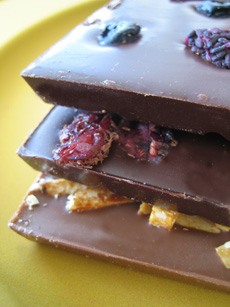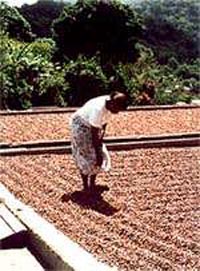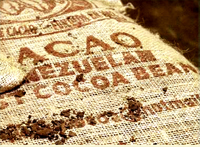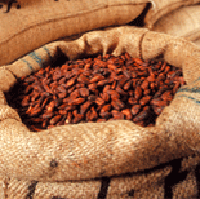 
Artisanal bars from Michael Mischer Chocolates of Oakland, California. Photo by Melody Lan | THE NIBBLE.
|
KAREN HOCHMAN’s first word was not cacahuatl...but as her mother will attest, it was pretty close.
|
|
May 2006
Revised January 2009
|
 |
From Pod to Palate: The Birth Of The Bar
Page 3: Drying & Cleaning The Cacao Beans
This is Page 3 of a 10-page article on chocolate production. Click on the black links below to visit other pages.
4. Drying
 Next, the fermented beans are spread out in the sun to dry, often on bamboo mats, and are turned often to make sure that they dry evenly and do not stick together. Drying can take place for 5 to 12 days, depending on the humidity, during which time the moisture content of the bean is substantially reduced. Next, the fermented beans are spread out in the sun to dry, often on bamboo mats, and are turned often to make sure that they dry evenly and do not stick together. Drying can take place for 5 to 12 days, depending on the humidity, during which time the moisture content of the bean is substantially reduced.
Drying can be done by the sun or by artificial techniques. Sunlight drying, which is used for better beans, takes several days but produces better results. Growers of bulk beans use hot air or heat from burning wood to dry the beans. This is fast, but imparts an undesirable, somewhat smoky permanent flavor. Photo courtesy of Amedei Chocolate.
Once dry, the beans are hand-sorted, graded and packed into jute bags weighing about  138 pounds (62.54 kg). These dry beans are referred to as raw cacao. The bagged beans are stored in warehouses prior to being transported for sale at the nearest port or other trading point. The beans are inspected, and then selected by the buyer or agent of the chocolate producer and are shipped to a chocolate manufacturing facility or warehouse anywhere in the world. 138 pounds (62.54 kg). These dry beans are referred to as raw cacao. The bagged beans are stored in warehouses prior to being transported for sale at the nearest port or other trading point. The beans are inspected, and then selected by the buyer or agent of the chocolate producer and are shipped to a chocolate manufacturing facility or warehouse anywhere in the world.
Photo courtesy of Scharffen Berger Chocolate.
5. Cleaning
 When the beans arrive at the factory, they are first inspected and approved by Quality Control. Then they are then sorted by country of origin and type of bean, and cleaned and roasted before they are made into chocolate. When the beans have been received at the processing location, they are inspected and thoroughly cleaned of all extraneous matter as well as any broken beans. The cleaning process involves blowers, which remove items that are lighter or heavier than cocoa beans, and sieves that eliminate items that are too small or too big. A special machine uses air suction, magnetic separators and brushes to remove foreign matter such as jute fibers from the bags; sticks, stones and sand; metal and fragments from closures used in bagging and tagging. Photo courtesy of Michel Cluizel. When the beans arrive at the factory, they are first inspected and approved by Quality Control. Then they are then sorted by country of origin and type of bean, and cleaned and roasted before they are made into chocolate. When the beans have been received at the processing location, they are inspected and thoroughly cleaned of all extraneous matter as well as any broken beans. The cleaning process involves blowers, which remove items that are lighter or heavier than cocoa beans, and sieves that eliminate items that are too small or too big. A special machine uses air suction, magnetic separators and brushes to remove foreign matter such as jute fibers from the bags; sticks, stones and sand; metal and fragments from closures used in bagging and tagging. Photo courtesy of Michel Cluizel.
Continue To Page 4: Roasting The Beans
Go To The Article Index Above

|





 Next, the fermented beans are spread out in the sun to dry, often on bamboo mats, and are turned often to make sure that they dry evenly and do not stick together. Drying can take place for 5 to 12 days, depending on the humidity, during which time the moisture content of the bean is substantially reduced.
Next, the fermented beans are spread out in the sun to dry, often on bamboo mats, and are turned often to make sure that they dry evenly and do not stick together. Drying can take place for 5 to 12 days, depending on the humidity, during which time the moisture content of the bean is substantially reduced. 
 When the beans arrive at the factory, they are first inspected and approved by Quality Control. Then they are then sorted by country of origin and type of bean, and cleaned and roasted before they are made into chocolate. When the beans have been received at the processing location, they are inspected and thoroughly cleaned of all extraneous matter as well as any broken beans. The cleaning process involves blowers, which remove items that are lighter or heavier than cocoa beans, and sieves that eliminate items that are too small or too big. A special machine uses air suction, magnetic separators and brushes to remove foreign matter such as jute fibers from the bags; sticks, stones and sand; metal and fragments from closures used in bagging and tagging.
When the beans arrive at the factory, they are first inspected and approved by Quality Control. Then they are then sorted by country of origin and type of bean, and cleaned and roasted before they are made into chocolate. When the beans have been received at the processing location, they are inspected and thoroughly cleaned of all extraneous matter as well as any broken beans. The cleaning process involves blowers, which remove items that are lighter or heavier than cocoa beans, and sieves that eliminate items that are too small or too big. A special machine uses air suction, magnetic separators and brushes to remove foreign matter such as jute fibers from the bags; sticks, stones and sand; metal and fragments from closures used in bagging and tagging.